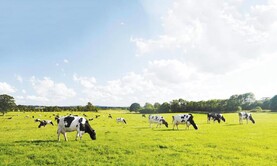Over the last few years, the prevalence of herds being milked once a day (OAD) in Ireland has increased dramatically.
There are now a few hundred farmers practising the technique for all or considerable parts of the year.
From a workload point of view it is great, as it dramatically reduces the time spent milking. It should be noted that this is not a 50% reduction in milking times as OAD milking takes longer per milking as more milk is being harvested per milking compared to twice-a-day (TAD) milking.
Drawback
The big drawback is the reduction in yield when cows are milked OAD. This drop in yield varies, but is generally around 30% in milk volume and 20% in solids.
Farmers who practise OAD milking over a number of years should reclaim some of this drop in yield through a lower replacement rate and better cow selection. See article in the current Irish Dairy Farmer magazine for more details.
Now, however, a new system of milking is coming into vogue. I shouldn’t say this is new as it has been around for a few years, but new data is coming available from research work and pilot farm studies in New Zealand.
This work is headed up by Paul Edwards, who spent some time in Moorepark about 10 years ago. The concept is reduced milking times but not OAD and not TAD.
Three-in-two milking
The concept is called three-in-two, effectively three milkings in two days. However, there are many different variations of this such as nine-in-seven or 10.5-in-seven.
The thinking is that reduced milking times are better for staff as they get more time off or more time to focus on other tasks and at the same time milk yield is not compromised to the same level as it is with OAD milking.
At its basic level, three-in-two milking involves two 18-hour milking intervals and one 12-hour milking interval. However, most farmers who practise this don’t stick to those exact times as a 12-hour milking interval is very unsociable, involving an early start to the day and a late finish.
An exact 12-18-18 milking interval would look something like a 5am start one morning followed by a 5pm start that evening. The next day the cows would be milked at 11am and the next milking would take place the following morning at 5am, followed by evening milking at 5pm and so on.
In order to avoid the 5pm milkings, many farmers will milk at 3pm in the evenings. In the Irish context, this could be a 4pm milking which would still allow most farmers to be finished by 5pm.
Results
Results in New Zealand show that over the course of the year, a herd producing 460kgMS/cow on TAD milking would suffer a 5% drop in milk yield per cow while on three-in-two milking for the full season.
The issue with three-in-two is that every second Sunday will involve two milkings. Switching to 10-in-seven means that cows are milked TAD every Monday, Wednesday and Friday and OAD every day in between including the weekends.
Anecdotal evidence would suggest that the impact on milk yield would be greater at 10-in-seven compared to three-in-two, but that it is still substantially higher than OAD.
An update on the results from these trials will be published in the Irish Farmers Journal over the coming weeks.






 This is a subscriber-only article
This is a subscriber-only article











SHARING OPTIONS: